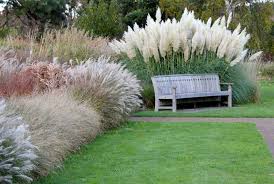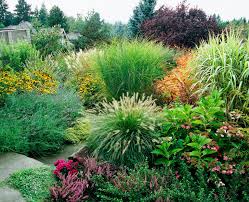Grasses are fantastic choices for adding charm and beauty to your outdoor space through landscaping. These versatile plants come in all shapes and sizes, and they require minimal effort to maintain. If you’re thinking about enhancing your yard, garden, or pathway, consider the many benefits that different grasses can bring to your landscape design.
One of the best things about using grasses for landscaping is that they can fit into almost any environment. It doesn’t matter if your area is mostly sunny or shady, wet or dry – there’s likely a kind of grass that will do well there. These decorative grasses come in many heights, colors, and textures, which means you can easily pick ones that match your personal style.
Taller grasses, like Miscanthus or Switchgrass, can help you create private spaces in your yard, provide some protection from the wind, or simply add a vertical element to your landscape. When a breeze passes through, these grasses sway gracefully, adding a sense of movement and life. On the other hand, shorter grasses like Blue Fescue or Fountain Grass are perfect for lining walkways, outlining flower beds, or filling in spaces between other plants.
You’ll be glad to know that grasses don’t demand a lot of attention, making them perfect for both experienced gardeners and those who are just starting out. Once they’ve settled in, they don’t require as much water or fertilizer as many other garden plants. This can help you save on water bills and create a more environmentally friendly landscape. What’s more, most grasses have a natural resistance to pests and diseases, which adds to their ease of care.
Throughout the year, grasses bring different dimensions to your landscape as the seasons change. In the warmer months, they burst forth with lively green shades, swaying gently with the breeze. As autumn arrives, some grasses take on warm hues of red, bronze, or purple, adding a cozy touch. Even in winter, ornamental grasses stand out with their delicate seed heads and frost-covered stems, creating a stunning sight against the winter backdrop.
But it’s not just about looks – using grasses in your landscaping can also be good for the environment. These plants help keep the soil in place, prevent erosion, and provide homes for bugs and birds. Grasses can also support a sustainable garden by attracting pollinators and beneficial insects, creating a healthier ecosystem.
When you’re thinking about using grasses in your landscaping, take into account factors like how much sunlight your area gets, the type of soil you have, and your overall design goals. By combining different types of grasses with plants, flowers, and other landscaping features, you can create a balanced and beautiful outdoor space.
In addition, grasses for landscaping offer many advantages, from their ability to thrive in different conditions to their low-maintenance needs. With careful selection and arrangement, you can design an enchanting outdoor area that showcases your personal taste and highlights the natural beauty of your surroundings. So, whether you have a large yard or a small garden, consider adding grasses to your landscaping for a delightful and picturesque result.
Read Also: Great Dane Dogs Description and Complete Care Guide
Benefits of Incorporating Grasses into your Landscaping

Grasses offer a wide array of benefits when integrated into your landscape design. From enhancing aesthetics to promoting ecological well-being, here are some compelling advantages of using grasses for landscaping:
1. Aesthetic Appeal: Different types of grasses introduce a variety of colors, textures, and heights to your landscape, adding visual interest and creating focal points.
2. Versatility: Grasses thrive in diverse environments, accommodating various sunlight levels, soil types, and moisture conditions.
3. Low Maintenance: Once established, grasses generally require minimal care, reducing the time and effort needed for upkeep compared to traditional garden plants.
4. Water Efficiency: Many grasses are drought-tolerant, contributing to water conservation and potentially reducing your water bills.
5. Natural Windbreaks and Privacy: Taller grass varieties can serve as natural barriers, offering protection from winds and enhancing privacy in your outdoor space.
6. Erosion Control: Grasses play a crucial role in stabilizing soil, preventing erosion, and maintaining the integrity of your landscape.
7. Wildlife Habitat: Grasses provide homes and food sources for insects, birds, and other wildlife, contributing to a healthier ecosystem.
8. Pollinator Attraction: Certain grasses attract pollinators like bees and butterflies, promoting biodiversity and supporting the reproduction of plants.
9. Year-Round Interest: Throughout the seasons, grasses offer dynamic changes in appearance, from vibrant green growth in spring and summer to captivating seed heads and warm hues in fall and winter.
10. Sustainable Landscaping: Incorporating grasses into your landscape design aligns with sustainable gardening practices, helping to reduce environmental impact and support local ecosystems.
11. Economic Benefits: Grasses’ low-maintenance nature can lead to reduced gardening expenses and water usage, providing cost savings over time.
12. Ease of Design: Grasses can be strategically placed to define borders, soften edges, or create pathways, allowing for creative and flexible landscape designs.
13. Texture and Movement: The swaying of ornamental grasses in the wind adds a sense of movement, bringing life and energy to your outdoor space.
14. Seasonal Interest: Grasses adapt to the changing seasons, offering a dynamic and ever-evolving landscape that remains captivating year-round.
15. Elegant Simplicity: Grasses bring a touch of natural elegance to your landscape, complementing various design styles from modern to traditional.
Incorporating grasses into your landscaping not only enhances the visual appeal of your outdoor area but also contributes to environmental sustainability and creates a harmonious and welcoming atmosphere for you, your family, and your guests.
Read Also: Greyhounds Dogs Grooming and Complete Care Guide
Low Maintenance Landscaping

You don’t need to spend tons of time on your yard to make it look fantastic. By using simple tricks for easy landscaping, you can have a beautiful outdoor space without too much effort. Here’s how to create a lovely garden that doesn’t need constant attention:
1. Pick Plants Wisely: Choose plants that like your weather and soil. Native plants and ones that don’t need a lot of water are good choices.
2. Mulch Helps: Put mulch around your plants. It keeps the soil damp, stops weeds from growing, and keeps the ground warm, so you don’t have to water or weed as much.
3. Water the Smart Way: Use drip hoses or soaker hoses to water your plants. They give water right to the roots, which helps plants grow strong and uses less water.
4. Group Similar Plants: Put plants that need the same amount of water and sun together. That way, you can take care of them all at once.
5. Plants That Stay Around: Go for plants that come back year after year. You won’t have to plant new ones every year.
6. Go for Local Plants: Use plants that are from your area. They’re used to the weather, and bugs and sicknesses don’t bother them as much.
7. Use Stones and Paths: Make paths and put down stones. This way, you don’t have to cut the grass as much.
8. Trim Less: Get plants that don’t grow too fast or need a lot of cutting. This saves you time on trimming.
9. Native Ground Covers: Try covering some parts of your lawn with native plants, rocks, or mulch. You won’t have to water or mow as much.
10. Strong Bushes and Trees: Plant bushes and trees that can take care of themselves. They look good all year and don’t need much care.
11. Plan Well: Think about how to make your garden easy to take care of. Put the plants where you can reach them, and make spaces for sitting and playing.
12. Good Dirt: Keep your soil healthy by adding things like compost. Healthy soil makes plants grow better.
13. Simple Flowers: Choose flowers that don’t need a lot of looking after. Native wildflowers and tough perennials are good options.
14. Not Too Close: Don’t plant your plants too close together. When they’re crowded, they need more care.
With a little bit of planning and some easy techniques, you can create a garden that looks amazing without needing too much work. Your yard will become a peaceful and pretty place where you can enjoy spending time.
Read Also: Exploring The Benefits of EPR Recycling
